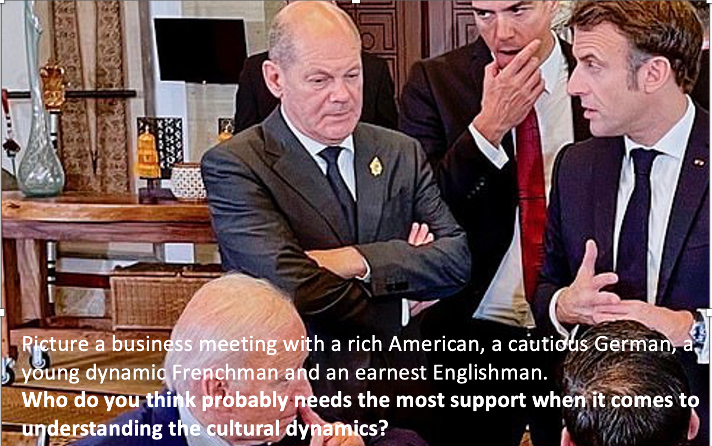


#1 Cultural dynamics
What do you think when someone says…
Let’s do lunch soon-they're inviting me to a business lunch or it’s just an empty phrase.
I hear what you are saying-they're being argumentative, or they actually agree with me.
That’s an interesting idea-they really like my idea or they hate it really.
That’s not too bad-it is really bad or it just needs a few changes.
Well, it might depend on whether you are British or from the USA.
In fact, many UK companies find it harder to work with American firms than with those from other countries. Even though they speak the same language, the way they use it can be quite different. For example, a British company might find an American partner too direct or overly enthusiastic, causing some confusion.
Language can be tricky. British English, with its unique phrases, might not always be clear to an American. A real-life example is when a UK company said they would "table the discussion" with a US firm. In the UK, this means they would bring up the topic. But in the US, it means to put the topic aside. This caused a delay in making an important decision.
A survey of British and American workers (1) found that, the British are more likely than Americans to take things negatively or see a subtext in casual communication. Americans, on the other hand, are most likely to take things literally and see the positives.
For example, when an American says “let’s do lunch soon” to UK colleagues, only 20% people in the UK see this as a positive statement, compared to almost half of Americans who mean this positively. This could be due to the British habit of taking things less literally and looking for subtext in communications – they may feel this statement is blasé or dismissive rather than a genuine offer of lunch.
Likewise, 59% of Americans use “I hear what you’re saying” positively when discussing ideas at work – but only 30% of British employees saw this as a positive statement. Often a British employee who is looking for subtext in communication might see this statement as dismissive and a prelude to a disagreement, while an American worker may take it as a more literal expression of respect.
Just over half of Americans would use the phrase “that’s not bad” as a positive. The British, however, were more likely to see a negative subtext in this statement, with only 39% agreeing it was a positive statement and 20% using this as a negative communication. Again, an American using this statement may be being very literal – if something is ‘not bad’, it is ‘good’. A Brit on the other hand may be politely using this phrase as a negative to mean something is not terrible, but it’s not particularly good either.
The structure of companies can also be a challenge. British firms might find the American approach to management less formal and the German approach very structured.
Erin Meyer's "Culture Map" is a great tool that sheds light on these differences. For German managers working with UK or US teams, three main steps can help:
1. Open Communication: Always clarify meanings. If something seems unclear, ask. For instance, when the British software firm collaborated with a German tech company, misunderstandings arose due to different interpretations of project timelines. Regular check-ins could have prevented this.
2. Training Sessions: Invest in cross-cultural training. Understanding basics, like how feedback is given or how decisions are made in other cultures, can be beneficial.
3. Embrace Differences: Recognize that each culture brings something valuable. German precision, British diplomacy, and American innovation can be a powerful combination if blended well.
In conclusion, working with different cultures is rewarding but requires effort. By understanding and valuing these differences, companies can make the most of international partnerships.
Links
1 https://tollfreeforwarding.com/blog/uk-vs-us-understanding-communication-differences-at-work/
Presentation tips
Creating interesting and attractive graphics to use in your presentations can be quite challenging if you haven’t got a background in graphic design. But I recently found an easy way to create some interesting backgrounds for PowerPoint slides. If you have access to Microsoft 365 then you can play around with the picture library and the designer function to create random graphics to use.
Start by inputting a word or phrase you are interested in, the online library will provide you with a graphic based on your input.
Then, copy the graphic and paste it onto the slide so that you have it twice. This should then trigger the designer function to create an interesting range of slides with two versions of your original slide. Keep asking for more design ideas until you find one you like. You can try a slide with three imprints of your graphics to see what the designer will produce or try putting two graphics together. This is how I produced the graphic at the start of the newsletter.
#3 Podcasts
Will robotaxis ever be viable?
The FT’s Patrick McGee pays a visit to two of the world’s top robotaxi operators and gets an insider’s take on how the tech, and the business model, are panning out.
The Financial Times is great for creating and making videos freely available on You Tube. This video is an interesting one which looks at the use of robotaxis in San Francisico and asks will they ever be commercially available?
The video is well made and lasts just over 9 minutes which is a good length for such report.
